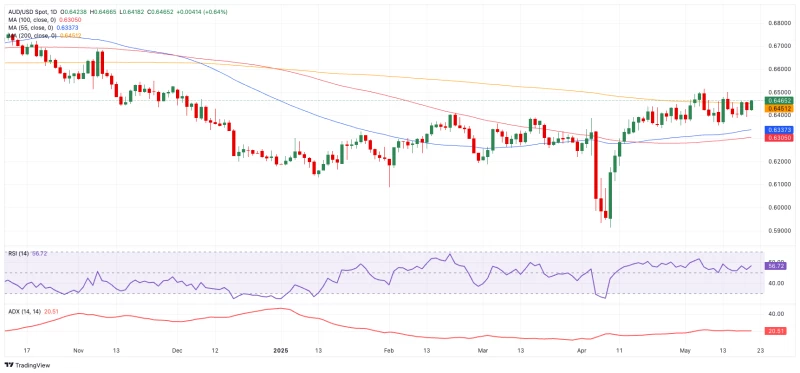The Australian Dollar (AUD) shook off Tuesday's slump, climbing back above 0.6400 against the greenback and flirting with its crucial 200-day moving average near 0.6460, as the widening gap between Fed and RBA policies takes center stage.
The AUD has shown some serious bounce-back energy this week, quickly recovering from Tuesday's dip to push back above the 0.6400 mark. The currency pair is now testing its make-or-break 200-day moving average around 0.6460 as traders weigh up the growing policy gap between the US Federal Reserve and Australia's central bank.
AUD/USD Caught Between Fed Patience and RBA Action
The growing split between what the US Fed and RBA are doing with interest rates has become the big story driving the AUD/USD lately, creating both headwinds and opportunities for the Aussie.
At its May 7 meeting, the Fed kept rates on hold, with Powell striking a cautious tone and basically saying "let's wait and see what happens" before making any moves. With inflation cooling in April and trade tensions easing a bit, markets are now betting the Fed might finally cut rates around September.
Meanwhile, the RBA just pulled the trigger on a 25-point rate cut on May 20, bringing rates down to 3.85% – exactly what most analysts were expecting. This signals Australia's slow pivot away from tight money as economic clouds gather. Their latest policy report suggests rates will likely drift down to around 3.2% by 2027, marking a gradual unwinding of the post-COVID tightening cycle.
While the RBA admitted policy is now "a bit less restrictive," they're still playing it safe, pointing to major question marks over both supply and demand trends in the economy. They've also trimmed their growth outlook for 2025 to 2.1% and lowered their core inflation forecast to 2.6%.
Australian Dollar (AUD) Losing Its Chinese Safety Net
Earlier this week, the AUD got a temporary boost from mixed Chinese economic data, which showed the economy's still hanging in there despite signs of cooling. Strong factory output numbers were offset by weaker retail and investment figures, suggesting a mild slowdown in Q1 but still keeping China on track for roughly 5% growth in Q2.
Despite these somewhat encouraging numbers, let's face it – China's economy is still struggling to find its footing after the pandemic. This spells trouble for the Aussie dollar, given Australia's heavy reliance on Chinese demand for its commodity exports.
Ongoing worries about potential US tariffs on Chinese goods and the endless saga of China's troubled property market remain dark clouds on the horizon. Worth noting that China's central bank just cut its key lending rates by 10 basis points on Tuesday – a move that initially helped the Australian Dollar but failed to provide lasting support.
AUD/USD Bears Finally Easing Their Grip
According to the latest CFTC data from May 13, speculative bets against the AUD seem to be leveling off. Net short positions hovered around 49,300 contracts, near multi-week lows, with slightly declining open interest suggesting traders are becoming less bearish on the currency.
This shift in market sentiment could give the AUD/USD some breathing room if Australian economic data holds up and if global risk appetite stays positive. But much depends on how interest rate expectations evolve for both the Fed and RBA in the coming months.
AUD/USD Charts: Still Searching for Direction
From a technical standpoint, the AUD/USD needs to crack above that stubborn 200-day average at 0.6454 to regain any serious upward momentum. A solid break above this level could open the door to a run at the year's high of 0.6514 (hit on May 7), followed by last November's peak of 0.6687.
On the downside, the pair finds immediate support at the May low of 0.6356 (touched on May 12), followed by the 55-day and 100-day averages at 0.6335 and 0.6303, respectively. If these floors give way, we're looking at much deeper trouble, with the 2025 bottom at 0.5913 (from April 9) and the March 2020 pandemic crash low at 0.5506 coming into focus.
Momentum indicators are offering a cautiously positive picture for the AUD, with the RSI approaching 57 and the ADX around 21, hinting at a modest uptrend starting to form.
As markets navigate these tricky currents, the AUD/USD will likely remain super sensitive to shifts in risk appetite, Chinese economic developments, and most importantly, any surprise moves from either the Fed or RBA regarding their interest rate paths.

 Saad Ullah
Saad Ullah

 Saad Ullah
Saad Ullah

